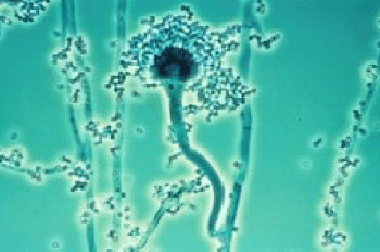Infectious diseases >>>> Why is aspergillosis dangerous?
Why is aspergillosis dangerous?

A variety of molds of the genus Aspergillus is found everywhere in nature. Their habitat is soil, air, water, walls of premises, air ducts, deposits of hay, dusty objects and household items, food, industrial and household goods stored in warehouses, and so on. Aspergillus are unpretentious, resistant to external influences, practically do not lend themselves to chemical action, with the exception of formalin, carbolic acid, which puts them in a number of microorganisms that are extremely dangerous to the health of animals and humans.
Aspergillus produce enzymes and toxins that cause allergic reactions, toxicosis and tissue abscess formation, affect almost all tissues and organs. Getting into the body by an aerogenic route or through broken skin and mucous barriers, aspergillus with the blood flow is carried throughout the body, including in the lymphatic system. When spores are inhaled, Aspergillus spreads in the respiratory system, affecting the bronchi and lung tissue.
With reduced immune reactions, which is a favorable condition for Aspergillus, there is a danger of generalized damage to the body by Aspergillus. This often leads to death (50% of deaths).
The risk group for aspergillosis includes workers in animal husbandry and poultry; agricultural workers and land workers; workers in spinning and weaving factories; people with a hobby of breeding birds or houseplants; mushroom pickers; warehouse and library workers; production workers with a dusty atmosphere; builders, as well as people with low immune responses, HIV infected, AIDS patients, bronchial asthma, chronic bronchitis and other chronic diseases of the respiratory system. People who take drugs that lower immunity (corticosteroids, immunosuppressants, or drugs to inhibit tumor growth) are also at increased risk of aspergillosis.
Until now, the duration of the incubation period for Aspergillosis has not been precisely established .
The clinical signs of aspergillosis are manifested by the following symptoms associated with the area of the body affected by fungi:
- With damage to the nasal sinuses (aspergillosis of the sinuses), there is: nasal congestion, allergic sinusitis, headaches, necrotic formations on the nasal mucosa, sometimes when the process is chronized, spherical elements can be located in the sinuses - aspergillomas (accumulation of conidia of the fungus). With advanced variants of the disease, the ethmoid bones of the skull are damaged, the orbits and the brain are affected.
- With damage to the organs of hearing (ear aspergillosis ), the symptoms resemble the development of otitis externa and otitis media.
- When broncho-lung tissue is damaged (aspergillosis of the lungs ), there are: cough with grayish sputum or with green blotches (clots of conidia of the fungus), a moldy taste is felt in the oral cavity, and there is also a noticeable smell of mold from the mouth. The general condition is disturbed, weakness, sweating, chills, fever, shortness of breath and / or pain in the chest area appear.
- The septic form of aspergillosis (generalized aspergillosis) is characterized, in addition to the symptoms described above, by disorders of the gastrointestinal tract (liquid foamy stools), skin rashes, abscess formation of brain tissue, and possible subarachnoid bleeding.
The treatment of aspergillosis is faced with the difficulty of biochemical resistance of the pathogen to drug therapy. Medical treatment is based on the intake of antifungins, but they are not effective in all cases. The most common disease-causing strains of Aspergillus may be resistant to Amphotericin B. Some strains are susceptible to voriconazole. Intraconazole and Caspofungin are used as second-line drugs. Fluconazole has no effect on aspergillus. Surgical intervention is considered the most effective for the purpose of resecting parts of the affected organs and tissues. As supportive therapy, immunomodulatory agents, vitamin therapy, anti-inflammatory drugs are used.
Prevention of aspergillosis includes frequent ventilation of premises, combating dust and signs of mold, timely disinfection of air ducts, air conditioners, bath rooms, greenhouses.

Read

Read



























